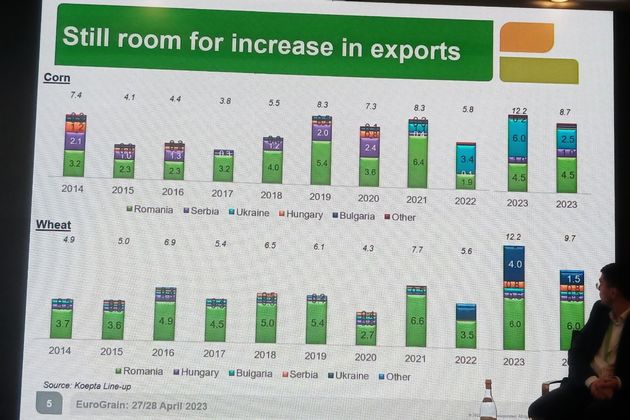Will the port of Constanta be able to handle all Ukrainian grain next season?

The Romanian port of Constanta is located on the western coast of the Black Sea and on the European Rhine-Danube transport corridor. It was here that some Ukrainian agricultural products were transported after the blockade of Black Sea ports by Russian troops. The port’s performance in previous seasons, Ukrainian exports of grains and oilseeds, and plans for the next period were discussed at the EURO GRAIN HUB Exchange & Forum in Romania. The event was organized by UkrAgroConsult, AgriPortal (Romania), and AgroPortal (Bulgaria).
Characteristics of the port of Constanta
The port complex covers 3.9 thousand hectares. Constanta consists of 4 zones and two satellite ports. The land-based facilities are located on an area of 1.3 thousand hectares, and the remaining 2.6 thousand hectares are covered by water. In total, the port has 156 berths with a total length of 32 km. Not all of them are in operation. Currently, 140 berths are operational. Depths range from 7 to 19 meters.
Constanta’s terminals can simultaneously store 1.5 million tons of agricultural products.
Bulk carriers with a maximum capacity of 220 thousand tons are loaded in the port.
It is possible to transship grain from a river barge to a ship, which should make it easier to work with Ukrainian agricultural products in the future.
Last year, the port’s total cargo traffic amounted to more than 70 million tons. Grain accounts for almost a third of this volume.
Constanta increases cargo transshipment volumes
Alexandru Neagu, Cargill trader, provided the statistics of grain and oilseeds transshipment through the port of Constanta in recent years. In general, there is an upward trend, he noted, but the poor harvests of 2020 and 2022 reduced the volume of supplies from Romania and neighboring countries that export through Constanta (with the exception of Ukrainian products last year).
For comparison: in 2015, 13.1 million tons of grain were shipped through the port, in 2016 – 15.8 million tons, in 2019 – already 18.8 million tons.
In 2021, a bumper year for Europe, a record-breaking 21.2 million tons of grain passed through Constanta. At that time, the share of Ukrainian grain was small: 1.1 mln tons of corn and 500 thsd tonnes of wheat.
But last year was a poor year for the EU due to drought, but due to grain from Ukraine, the port of Constanza showed a result of 16.5 mln tons from the beginning of 2022/23 MY to April this year. For comparison: in 2022/23 MY, 3.4 mln tonnes of Ukrainian corn were exported through Constanza.

Cargill trader Alexandru Neagu
The port of Constanta is preparing to transship Ukrainian grain in case the grain corridor is closed
Most market participants hope that the “grain corridor” in the Black Sea will continue to operate. However, the port of Constanta is considering scenarios with different transshipment volumes in case of its closure.
“We hope that the corridor will not be closed. Perhaps there will be a short stop for a few weeks or a month between seasons, but it will most likely continue to work. But even if the grain corridor is closed, Ukraine will be able to export 50 million tons of grain next year (marketing year – ed. note), because logistics through neighboring countries has improved significantly,” Alexandru Nahu believes.

Two scenarios for 2023: without extending the grain corridor and with working ports in Ukraine
The expert predicts that if Ukrainian exports through the ports of Greater Odesa are suspended, Constanza will receive about 6 million tons of corn and 4 million tons of wheat from the 2023 harvest.
“Of course, these are only rough estimates. In the scenario where the corridor is closed, we estimate that Constanta, including Romanian, Serbian and Ukrainian grain, will be able to transship 12 million tons of corn and about the same amount of wheat,” Alexandru Năgă said.
He noted that the Ukrainian ports of Reni and Izmail have increased their transshipment capacities, which will make it possible to export more grain, including through Constanta.
Constanta is increasing transshipment capacities on the water
Vladyslav Belakh, Deputy CEO of Ukrainian Danube Shipping Company, said that the company has developed its own logistics chain that will help increase exports through Constanta. It includes transshipment of dry bulk cargo, transportation of grain by barges to the Romanian port and its loading on board vessels on a side-by-side basis.
“We are considering increasing the transshipment capacity in the port of Constanta, which will speed up the processing of caravans,” the UDSC said.
According to Alexandru Nahu, the floating cranes in Constanta can handle about 2,500 tons of agricultural products per day.
“Most of the Ukrainian grain is actually delivered via barges. There are already 14-15 floating cranes in Constanta. The largest operator with 8 floating cranes is the DTS terminal, while other terminals have from 1 to 3 cranes. As we speak, 3-4 more floating cranes are on their way to Constanta. So, probably, we will have a total of 18-19 cranes for transshipment,” said the Cargill representative.
Assuming that there will be about 250 days in a year with good weather, which will allow transshipment of grain from barge to ship, Constanta will be able to transship 9 million tons by water alone. In general, the theoretical transshipment capacity of grains and oilseeds in the port reaches 30 million tons, but the expert estimates the real figures at 25-27 million tons.
This year, Ukrainian grain will compete with a large harvest in Romania and Slovakia for transshipment in the port of Constanta
The situation for Ukrainian exporters through Constanta may be complicated by a good harvest in Romania and neighboring countries, which is forecast for 2023. The flow of Romanian and Serbian grain to Constanta is likely to increase. The question of whether the port will be able to handle all these volumes remains open, says Alexandru Nahu.
However, he sees prospects in transshipment from barges to ships on the water.
“Since this situation started (the increase in grain volumes from Ukraine – ed.), everything has changed a lot. Initially, there were no barges, but now everything has changed a bit: according to our estimates, there are much more logistical capacities. Our colleagues from Ukraine will be able to deliver 1.5 million tons of grain per month with a caravan of barges, which is a significant increase. The number of barges has increased,” Alexandru Năgă said.
In general, the expert summarized that the absence of the “grain corridor” will be an extremely difficult task for the logistics of the Romanian port, but, according to him, relatively manageable.
Read also
Wheat in Southern Brazil Impacted by Dry Weather and Frosts
Oilseed Industry. Leaders and Strategies in the Times of a Great Change
Black Sea & Danube Region: Oilseed and Vegoil Markets Within Ongoing Transfor...
Serbia. The drought will cause extremely high losses for farmers this year
2023/24 Safrinha Corn in Brazil 91% Harvested
Write to us
Our manager will contact you soon



